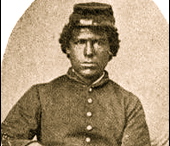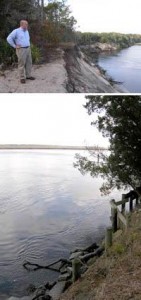The Battle of the Hundred Pines

The Battle of the Hundred Pines
‘Battle of the Hundred Pines:’ The real first black infantry regiment made history in Nassau County by Peg Davis, News-Leader
 Early on the morning of Jan. 26, 1863, while the 54th Massachusetts Infantry Regiment famously depicted in the movie “Glory” was still being trained, Company K engaged an expeditionary force of the First South Carolina Volunteers, and the “real” first black regiment in U.S. Army history found itself in its “first stand-up fight,” according to its commander, Maj. Thomas Wentworth Higginson.
Early on the morning of Jan. 26, 1863, while the 54th Massachusetts Infantry Regiment famously depicted in the movie “Glory” was still being trained, Company K engaged an expeditionary force of the First South Carolina Volunteers, and the “real” first black regiment in U.S. Army history found itself in its “first stand-up fight,” according to its commander, Maj. Thomas Wentworth Higginson.
Higginson, an abolitionist and Unitarian minister, was also a prolific writer. After the war Higginson detailed his experience leading the unit in a book entitled Army Life in a Black Regiment.
According to Higginson’s book, the initial expedition up the St. Marys was not to engage the Confederates at Camp Cooper, but to obtain lumber from Marion Wild’s sawmill, which was between the river and present day US 17, about 1 1/2 miles from the camp.
“The best peg on which to hang an expedition in the Department of the South in those days was the promise of lumber,” Higginson wrote. “Dwelling in the very land of Southern Pine, the Department authorities had to send North for it, at a vast expense. There was reported to be plenty in the enemy’s country.”
Higginson and his men steamed up the river with a half moon lighting their way on Sunday night, Jan. 25, 1863. Landing on the southeast end of the bluff below “Township,” which later became known as Crandall, Higginson left 100 men with the boats and set off with a sergeant named McIntyre and approximately 200 soldiers to find the mill.
“There was a trampling of feet among the advance guards as they came confusedly to a halt, almost the same instant a more ominous sound, of galloping horses in the path before us,” Higginson wrote. “The moonlight outside of the woods gave that dimness of atmosphere which is more bewildering than darkness, because the eyes cannot adapt themselves to it so well … Our assailants, dividing, rode along on each side through the open pine barren, firing into our ranks, but mostly over the heads of the men. I could hardly tell whether the fight had lasted ten minutes or an hour … when I gave the order to cease firing.”
“Retreating to the river, McIntyre burned the houses and Higginson returned to Fernandina with his dead and wounded. Higginson would later present a piano he took from one of the houses to “the school for colored children at Fernandina.”
Soldier of the 54th Regiment, Massachusetts Volunteers
Two weeks later a soldier in the Second Florida Cavalry named Davis Bryant wrote to his brother from Camp Cooper, telling the other side of the story. “One night, at about 11 o’clock … one of a picket (a guard or lookout) stationed at the St. Marys River, 5 miles from camp, reported a gunboat passing up. We had expected the Yanks would come that way if they ever came after us.” Twenty-nine soldiers and three officers then left the camp to engage the expedition.
Bryant described what happened next: “The Captain, feeling secure, carried us at a gallop intending to dismount us at a certain branch and there ambush them. But just as we were approaching our intended ambush … imagine our surprise on being ‘opened on’ by a line of Yankees about 60 yards long.”
“The shock was terrible, and frightened our horses so that they took us skitin through the woods in all directions,” Bryant writes. “The buggers were firing all the while as fast as they could load, and as the bullets were whizzing by … it was decided advisable that we fall back a little more, particularly as we knew that we could not check their advance at that place. We fell back another 50 yards and collected in the road, when one man was found to be wounded and our First Lieutenant and another found to be missing.”
The casualties from the “battle” were few. On the Confederate side the lieutenant was killed and two privates were wounded. On the Union side a private was killed and seven others wounded. One of the wounded would later die.
The mission had been a failure. The prized pine lumber stayed where it was.
Camp Cooper existed until the Confederate soldiers left it on Feb. 10, 1864, under orders to go to Lake City. Company K would later fight in the major battle at Olustee, in Baker County. Story created Jan. 6, 2007, pegdavis@fbnewsleader.com.
http://fbnewsleader.com/articles/2007/01/06/leisure/02aylhundredpines.txt


